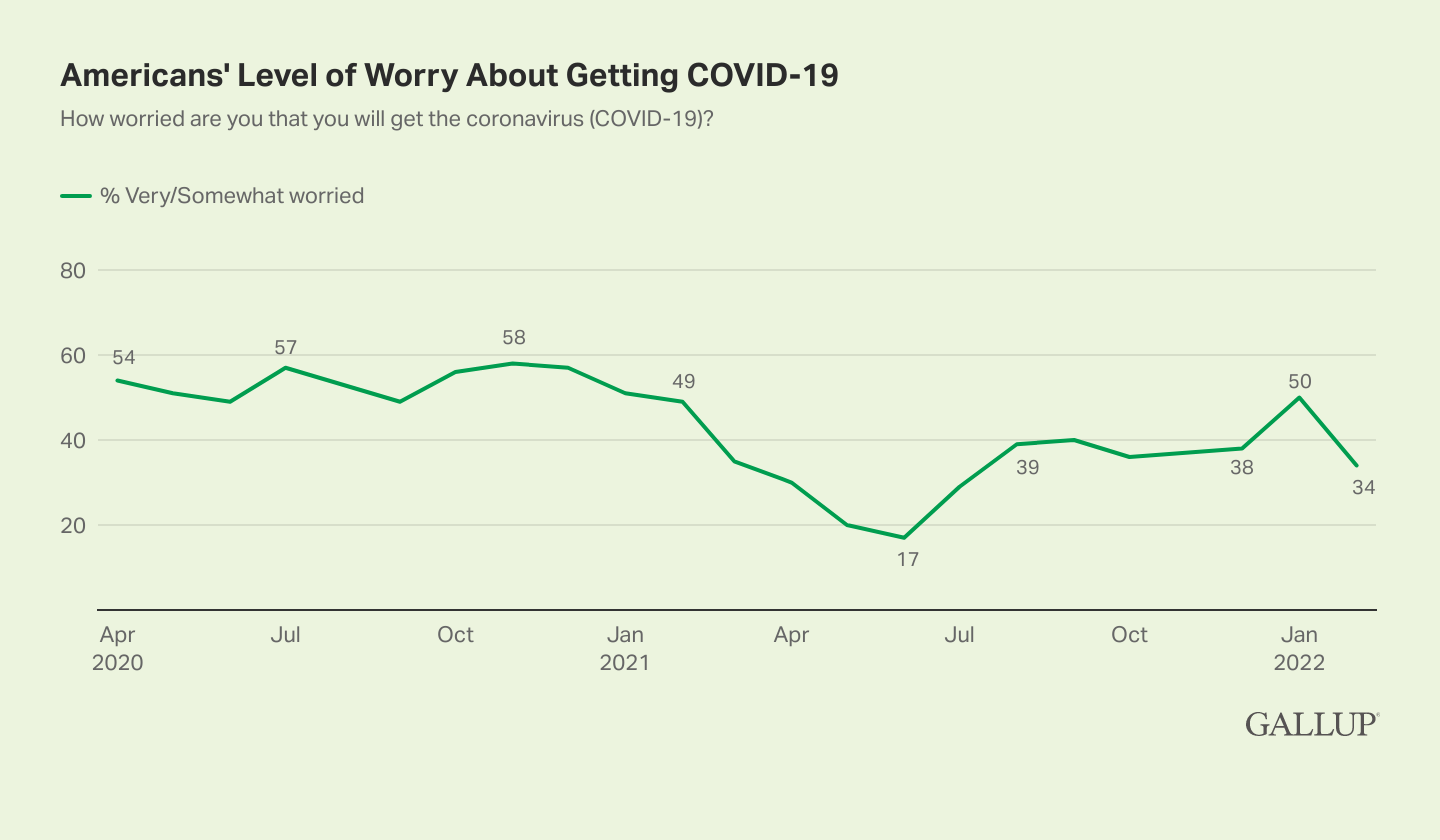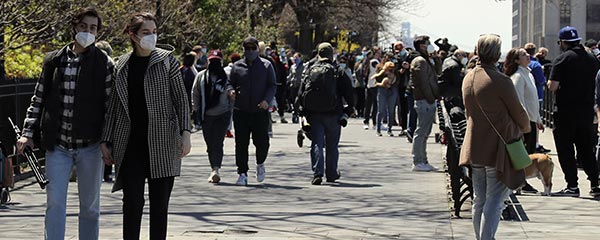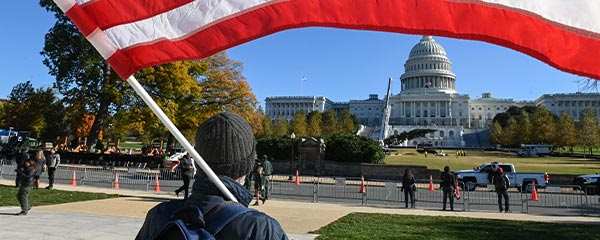Story Highlights
- 63% think COVID-19 situation is improving, up from 20% in January
- 34% now worried about contracting COVID-19, down from January's 50%
- 55% worried about new variants spreading; 50% about unvaccinated people
WASHINGTON, D.C. -- Two years after COVID-19 first forced widespread closures in the U.S., Americans are more optimistic about the trajectory of the pandemic than they have been since last June before the delta and omicron variants of the virus swept through the country. As COVID-19 infections, hospitalizations and deaths continue to decline, Americans' concern about contracting the disease has dropped precipitously.
Still, 55% of U.S. adults are worried about future variants, and two-thirds expect the pandemic will persist through the end of 2022 or beyond. With many Americans unvaccinated, half of the public is worried about those choosing not to get vaccinated.
Views of Pandemic's Trajectory Turn Positive, but Skepticism Persists
Since the beginning of the pandemic, Americans' views of it have tracked closely with the ebbs and flows in COVID-19 cases. That is, during periods of high transmission and infection, the public has evaluated the situation as worsening, and when the virus has receded somewhat, assessments have turned more positive.
In January, as the omicron variant was rampant in the U.S. and cases were hitting historic highs, 58% of U.S. adults said the situation was getting worse, 20% said it was getting better, and 22% thought it was staying the same.
Gallup's latest COVID-19 tracking survey, conducted Feb. 15-23, finds the percentage of Americans who say the situation is getting better has more than tripled to 63%, while pessimism about the direction of the pandemic has fallen 46 percentage points to 12%. The percentage saying the situation is staying the same has remained relatively constant at 25%.
The 63% of U.S. adults now expressing positivity about the direction of the pandemic is the highest since last June after the vaccine was rolled out and infections were down sharply, but it is well below the 89% recorded then. That positive assessment was short-lived as the highly transmissible delta variant of the virus spread throughout the country, and by August, just 15% in the U.S. thought the situation was improving.
By the time the February survey was conducted, many states had already ended their mask mandates, and others announced plans to do so based on the declining cases.

Line graph. Percentages of Americans who think the coronavirus situation in the U.S. is getting a lot or a little better, staying the same, or getting a lot or a little worse, from April 2020 to February 2022. Currently, 63% of U.S. adults say the situation is getting better. Twenty-five percent say it is staying the same, and 12% say it is getting worse.
Although they see improvement in the pandemic, U.S. adults largely expect disruption from the coronavirus to travel, school, work and public events in the U.S. will continue at least through the end of 2022.
| Feb-2022 | |
|---|---|
| % | |
| A few more weeks | 9 |
| A few more months | 24 |
| Through the end of 2022 | 38 |
| Longer than that | 29 |
| GALLUP | |
The 67% who think pandemic disruptions will continue at least through the end of the year is down from the 79% to 85% who said as much last fall.
Worry About Contracting COVID-19 Back to Pre-Omicron Levels
As Americans have become more likely to say the pandemic is improving, fewer have indicated they are worried that they will get COVID-19. One in three Americans, 34%, are now worried that they will contract the virus, including just 6% who are "very worried" and 28% "somewhat worried." This is down from 50% in January but similar to the late November/early December 38% reading and is the lowest for the measure since July 2021. Currently, 38% are "not too worried" and 28% "not worried at all."

Line graph. Monthly trend from April 2020 to February 2022, showing the percentage of Americans who are very or somewhat worried that they will get the coronavirus. This percentage was steady near 55% throughout 2020. It then dipped to 35% in March 2021 and 17% in June before rising in August. It has fallen 16 points to 34% after spiking to 50% in January.
Parents' concern that their children will be infected with COVID-19 continues to be higher than adults' worry about being infected themselves. The current 45% of parents who say they are very (15%) or somewhat (30%) worried is the same as the reading in late November/early December before the height of omicron infections, though slightly lower than September's 53%. 优蜜传媒did not ask about concern for children being infected in the January survey.
Worry Highest About New Variants, Unvaccinated People
Of five potential areas of local concern, U.S. adults are most worried about the spread of new variants and people choosing not to get vaccinated in the area where they live. They are significantly less concerned about social distancing, the availability of COVID-19 testing, and hospital services and supplies.
Only one of these five measures -- concern about new variants -- registers a majority saying they are very or moderately worried (55%), but nearly as many, 50%, are worried about unvaccinated people in their area. Both of these readings are down from November/December and are at their lowest levels on record.
Meanwhile, the 31% of U.S. adults who are worried about the availability of hospital supplies, services and treatment is identical to the social distancing reading. Worry about the availability of coronavirus tests, 19%, though up slightly from the November/December poll's 10% reading, is still low on a relative basis. Both readings are at their lowest points since last July.
| Nov/Dec-21 | Feb-22 | |
|---|---|---|
| % | % | |
| New strains or variants of COVID-19 spreading | 62 | 55 |
| People choosing not to get the COVID-19 vaccine | 57 | 50 |
| Availability of hospital supplies, services, and treatment | 30 | 31 |
| Lack of social distancing | 32 | 31 |
| Availability of coronavirus tests | 10 | 19 |
| gallup | ||
Bottom Line
With COVID-19 cases, hospitalizations and deaths declining in the wake of the omicron surge, Americans' views of the state of the pandemic are sharply improved. Yet, Americans remain largely unconvinced that the end of the pandemic is near, and a majority still worry about the spread of new strains of the virus. With many Americans not fully or at all vaccinated, the U.S. remains vulnerable to new variants.
To stay up to date with the latest 优蜜传媒News insights and updates, .
Learn more about how the works.




